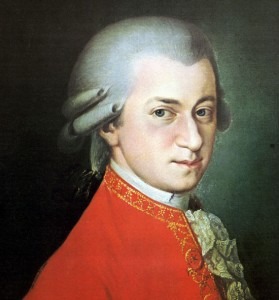
Mozart
Credit: http://kidsmusiccorner.co.uk/
Here’s the aria from Mozart’s Magic Flute, “Bei Männern, welche Liebe fühlen,” (In Men, who feel love) where Pamina and Papageno, who has just scared off Monostatos, pause to sing a little duet about love and how the noblest creation in the world is Man and Wife.
Mozart: Die Zauberflöte, Act I: Bei Männern, welche Liebe fühlen (Elisabeth Norberg-Schulz, Pamina; Georg Tichy, Papageno; Budapest Failoni Chamber Orchestra; Michael Halász, cond.)
The duet is very simple, reflecting the relative innocence of our two characters who are new to Love and have very basic thoughts on its complexity.
When Beethoven made his set of variations on this for cello and piano, the piano has the role of Pamina and the cello is Papageno. After their initial declaration of the themes, the lines start to get more complicated.
Beethoven: 7 Variations on ‘Bei Männern, welche Liebe fühlen’ from Mozart’s The Magic Flute: Theme: Andante (Hai-Ye Ni, cello; Helene Jeanney, piano)
The 1st variation speeds it all up into a chugging tempo and off we dance:
Variation I
The 2nd variation puts running notes into the top voices and puts the theme in the left hand in the piano.
Variation II
The 3rd variation returns us to something closer to the original theme, but the accompaniment in the piano has changed and “Papageno” gets to make the first statement.
Variation III
The 4th variation takes us to a delicate minor, where the deep voice of the cello, far below the high pitches of the piano, takes a more serious view of the whole idea.
Variation IV
Variation 5 is the first one with any sort of tempo designation: Si prenda il tempo un poco più vivace (Take the tempo a little more lively) and so they do:
Variation V
We return to the highly decorated lines in variation 6, with a slower tempo of Adagio. The cello imitates the piano and, in doing so, gives it more gravitas.
Variation VI
Variation 7, Allegro, ma non troppo (Fast, but not too much) takes us to a lively 6/8 time signature and we’re dancing again. The melody has changed here – we’re not on the main theme any more until the Coda begins and we hear our Theme return once again.
Variation VII
Variation sets were important tools for getting melodies from operas, which few people could hear in the original, out into the musical world. Since composers wanted to be inspired, a variation set was also a wonderful way of showing off all that you could do with a melody!
